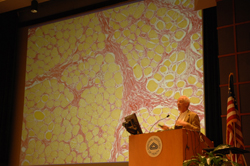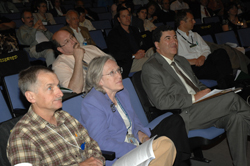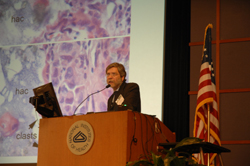NIH Symposium Explores Promise of Stem Cell Therapies
News
Press Releases
| News Articles |
Events
Calendar of Events
Proceedings
Congressional Testimony
NINDS is part of the
National Institutes of
Health
For release: Monday, July 14, 2008
Stem cells have been hailed as a toolkit to treat a host of diseases, but at an NIH symposium on May 6, researchers said they are still deciphering the toolkit's instruction manual.
 Hosted by the NIH Stem Cell Task Force, "Challenges and Promise of Cell-Based Therapies" brought together about 400 scientists
to discuss the clinical applications of embryonic and adult stem cells. Embryonic stem (ES) cells are pluripotent, meaning
they give rise to all the cell types of the body. Stem cells are also found in adult tissues, but whether they are truly
pluripotent is unknown.
Hosted by the NIH Stem Cell Task Force, "Challenges and Promise of Cell-Based Therapies" brought together about 400 scientists
to discuss the clinical applications of embryonic and adult stem cells. Embryonic stem (ES) cells are pluripotent, meaning
they give rise to all the cell types of the body. Stem cells are also found in adult tissues, but whether they are truly
pluripotent is unknown.
"Stem cells come in different flavors, and it is clear that there is no single best stem cell for all applications," said NINDS Director and Task Force Chair Story Landis, Ph.D., as the symposium began. Stem cell therapies for some diseases have been rigorously tested, but for most diseases, stem cells "are still on the drawing board," she said.
In the day's first presentation, Stuart Orkin, M.D., of the Dana-Farber Cancer Institute at Harvard, and the Howard Hughes Medical Institute, described the undisputed success story in stem cell therapy – the use of bone marrow transplants (BMT) to treat cancers. Bone marrow is a source of blood-forming stem cells that can replace cancerous blood cells or reconstitute the blood after chemotherapy. Dr. Orkin noted that umbilical cord blood also contains blood-forming stem cells, and is sometimes used as an alternative to bone marrow.
 The rest of the day was devoted to the exploratory use of stem cell therapy for neurological, cardiac, musculoskeletal, and
metabolic disorders – often with discussions about whether BMT could be adapted to treat them. The sessions were moderated
by Ronald McKay, Ph.D., Chief of the Laboratory of Molecular Biology at NINDS; Sonia Skarlatos, Ph.D., Acting Director of
the Division of Cardiovascular Diseases at NHLBI; Pamela Robey, Ph.D., Chief of the Craniofacial and Skeletal Diseases Branch
at NIDCR; and James Battey, Jr., M.D., Ph.D., Director of NIDCD and Vice Chair of the Stem Cell Task Force.
The rest of the day was devoted to the exploratory use of stem cell therapy for neurological, cardiac, musculoskeletal, and
metabolic disorders – often with discussions about whether BMT could be adapted to treat them. The sessions were moderated
by Ronald McKay, Ph.D., Chief of the Laboratory of Molecular Biology at NINDS; Sonia Skarlatos, Ph.D., Acting Director of
the Division of Cardiovascular Diseases at NHLBI; Pamela Robey, Ph.D., Chief of the Craniofacial and Skeletal Diseases Branch
at NIDCR; and James Battey, Jr., M.D., Ph.D., Director of NIDCD and Vice Chair of the Stem Cell Task Force.
The neurological disease session began with a talk by Mark Freedman, M.D., of the University of Ottawa and Ottawa Health Research Institute, who is testing BMT against multiple sclerosis, where immune cells in the blood attack the brain. Preliminary studies suggest that BMT reboots the immune system and leads to improvement in MS patients with early aggressive disease, he said.
The next two talks highlighted one of the day's themes: using stem cells to replace as opposed to using them to repair. Douglas Kerr, M.D., Ph.D., of Johns Hopkins University, is testing the ability of human ES cells to generate new neurons in animal models of spinal muscular atrophy. Meanwhile, Clive Svendsen, Ph.D., of the University of Wisconsin-Madison, is testing whether human fetal stem cells engineered to secrete growth factors can rescue neurons in animal models of Parkinson's disease and amyotrophic lateral sclerosis.
In the next session, Douglas Losordo, M.D., of Northwestern University, reviewed several studies with a single goal – testing bone marrow stem cells in human heart attack victims. There is hope that the bone marrow cells, infused into the heart, might generate or repair cardiac tissue, but study results have been inconsistent, he said. Next, Annarosa Leri, M.D., of Harvard Medical School, presented evidence that there are resident stem cells in the heart that decline with age, and that it might be possible to reactivate them. Finally, Michael Laflamme, M.D., Ph.D., of the University of Washington, described efforts to use human ES cells to regenerate cardiac muscle in animal models of heart disease.
Next, researchers described efforts to use stem cells derived from adult bone marrow and muscle to treat musculoskeletal disorders. "The emphasis [of this research] is going from replacement to repair," said Darwin Prockop, M.D., Ph.D., of Tulane University Medical School, who noted that while adult stem cells appear to have limited pluripotency, they do appear to secrete chemicals that promote cell survival.
 Dr. Prockop said clinical studies suggest that mesenchymal stem cells – a type of cell in bone marrow – are beneficial in
children with brittle bone disease. Paolo Bianco, M.D., of Universita' La Sapienza in Rome, said that experiments with mesenchymal
stem cells have also yielded insights into how bone cancers form. Finally, Terence Partridge, Ph.D., of Children's National
Medical Center, described how mesangioblasts – a type of stem cell in blood vessels – appear capable of enhancing muscle mass
in mice with muscular dystrophy.
Dr. Prockop said clinical studies suggest that mesenchymal stem cells – a type of cell in bone marrow – are beneficial in
children with brittle bone disease. Paolo Bianco, M.D., of Universita' La Sapienza in Rome, said that experiments with mesenchymal
stem cells have also yielded insights into how bone cancers form. Finally, Terence Partridge, Ph.D., of Children's National
Medical Center, described how mesangioblasts – a type of stem cell in blood vessels – appear capable of enhancing muscle mass
in mice with muscular dystrophy.
In the metabolic disorders session, Markus Grompe, M.D., of Oregon Health and Science University, and Kenneth Zaret, Ph.D., of Fox Chase Cancer Center in Philadelphia, described their research on cell therapy for liver disease. Both said that with a shortage of donated livers available for transplant, surgeons are increasingly looking toward stem cells as a source of healthy liver tissue – but the path from stem cell to mature liver cell is poorly understood. Linda Griffith, Ph.D., of the Massachusetts Institute of Technology, said that in order to use stem cells to rebuild the liver and other organs, scientists "need to understand the nanoscale biophysics of tissue" and how cells move within it.
In a final talk, George Daley, M.D., Ph.D., of the Harvard Stem Cell Institute, described new technologies that offer the promise of patient-specific stem cell therapy. For example, researchers have found that they can extract cells from adult tissue and turn them into ES-like cells, called induced pluripotent stem (iPS) cells. Patient-specific iPS cells would have the advantage of gliding past the body's immune defenses, but might prove too costly for most patients. One solution, Dr. Daley said, might be to create banks of immunologically matched iPS cells similar to bone marrow banks.
NIDCD's Dr. Battey closed the symposium by revisiting the first talk. Early research on bone marrow stem cells took place more than 50 years ago, he said. "It takes time to characterize a population of cells and bring it to the clinic."
-By Daniel Stimson, Ph.D.
Date Last Modified: Thursday, July 17, 2008



